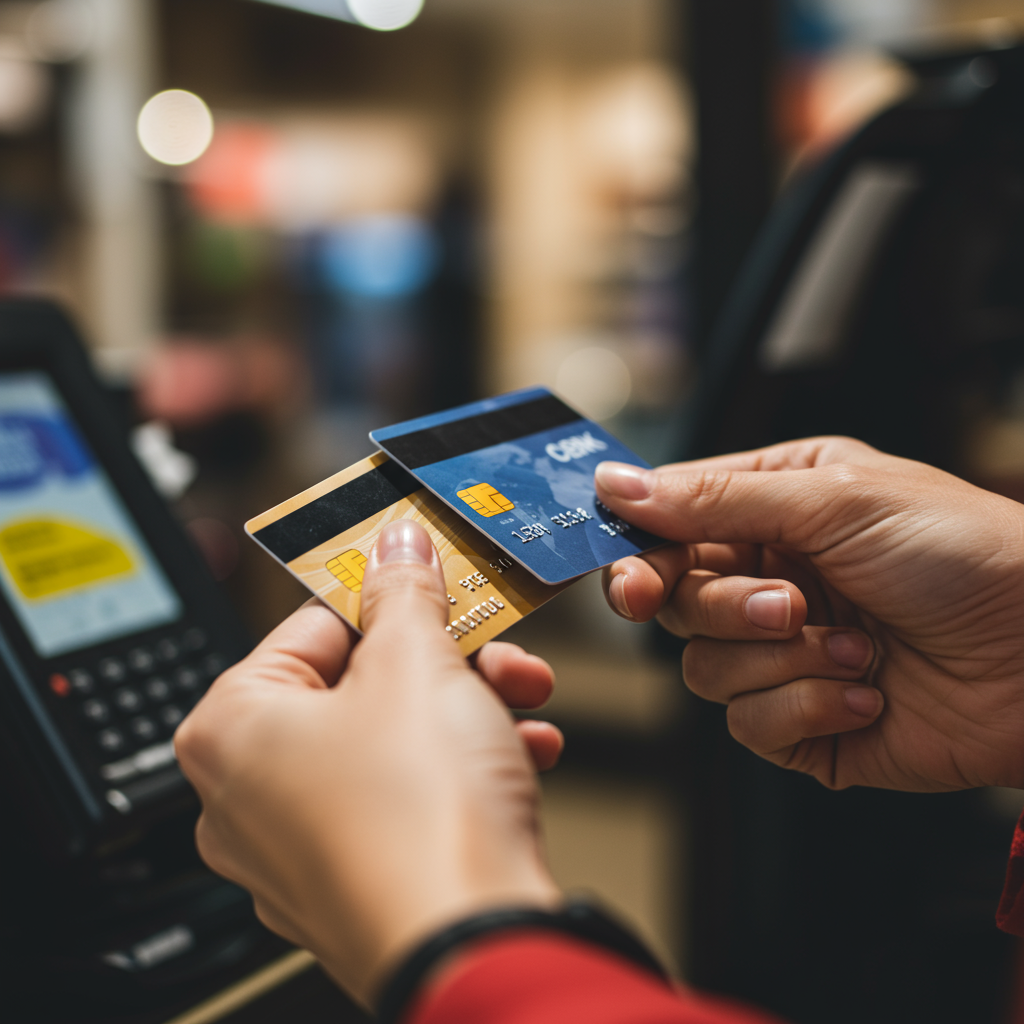
Table of Contents
Introduction
Have you ever stood at the checkout counter, wondering whether to swipe your credit card or your debit card? This common dilemma reflects a larger question about managing personal finances wisely in a world brimming with payment options. Understanding the core differences between credit and debit cards is essential for making informed decisions that can impact your financial health, budgeting strategy, and creditworthiness.
In recent years, the growing reliance on electronic payment methods has transformed the way we handle money daily. According to recent statistics, over 70% of adults in the United States use credit cards, while debit cards remain equally popular for their direct access to funds. Yet many people remain unclear about the different roles these cards play, how transactions affect their money, and the broader implications for their financial lives. For example, using a debit card means spending money that you already have in your bank account, while credit cards allow you to borrow up to a set limit and pay later, often with interest.
This distinction has significant importance. While debit cards help consumers avoid debt accumulation by limiting spending to available funds, credit cards offer opportunities to build credit history, access rewards, and enjoy protections against fraud. However, misuse of credit cards can lead to mounting balances and fees that undermine financial goals. Conversely, debit cards may not provide the same level of security or benefits often found with credit cards. These contrasts make it critical to understand not just what each card does but when to use each one effectively.
Knowing the difference between these two payment methods goes beyond simple convenience; it empowers you to navigate everyday purchases responsibly and strategically. If you’re new to the topic, you might want to start with how to read a credit card statement, which plays a crucial role in monitoring your credit card usage and avoiding unnecessary charges. Exploring such resources can deepen your understanding of financial tools and improve your money management skills.
Many individuals face uncertainty when it comes to credit card interest, payment deadlines, and the impact of their spending on credit scores. These concerns are valid and highlight why gaining clear knowledge is a vital step toward financial confidence. If you’re curious about managing payments or want practical advice on avoiding interest charges, you may find valuable insights in the article on how to avoid credit card interest charges. These articles provide foundational knowledge that supports better decisions, making your financial journey smoother and more manageable.
What You’ll Learn in This Guide
In this comprehensive guide, we’ll walk you through everything you need to know about the differences between credit and debit cards. Here’s what we’ll cover to help you become a more informed and empowered financial consumer:
- Understanding Debit Cards: You’ll learn how debit cards operate by linking directly to your checking account, allowing immediate deduction of funds with each purchase. This section explains the types of debit transactions, including PIN and signature-based methods, to give you a well-rounded view.
- Understanding Credit Cards: Explore how credit cards function as a borrowing tool, providing a credit line from the issuer and requiring monthly payments. You’ll also learn about interest charges on carried balances and the advantages of building credit history and accessing rewards.
- Key Differences Explained: We will clearly compare the main differences between debit and credit cards, focusing on spending limits, payment timing, fees, credit impact, and security protections, helping you choose wisely.
- Best Use Cases and Security Tips: Gain practical guidance on when to use each type of card and how to protect yourself against fraud and misuse. Learn essential security practices specific to both credit and debit cards to safeguard your finances.
As we delve into these topics, you’ll gain actionable knowledge that not only clarifies the distinctions but also empowers you to make confident choices aligned with your financial goals and lifestyle. Whether you prefer the simplicity of a debit card or the benefits of credit cards, this guide equips you with the insights you need to use these tools effectively.
In the sections ahead, we will examine each card in detail, highlight their advantages and limitations, and help you understand the factors that should influence your choice. By the end, you will confidently understand how these cards fit into your broader personal finance strategy, from budgeting to credit building.
So, whether you’re a student learning to manage your finances, a professional seeking smarter spending habits, or someone wanting clarity on financial products, this guide was designed to provide clear, practical answers. Now, let’s embark on this journey to financial clarity, beginning with understanding what a debit card is and how it works.

Understanding the fundamental differences between credit cards and debit cards is essential for making well-informed financial decisions. Both types of cards are widely accepted methods of payment and offer convenience, but their underlying mechanisms and implications for your finances vary significantly. This discussion section will dive deeper into these differences, helping you to understand when and how to use each card type to maximize benefits and minimize risks. Whether you are managing daily expenses, planning large purchases, or seeking to build your credit history, knowing these distinctions will empower you to make choices aligned with your financial goals.
How Debit Cards Operate and Their Key Benefits
Debit cards are directly linked to your checking or savings account, allowing you to spend only the money you have available in your account. When you use a debit card, funds are typically deducted from your account immediately or within a short processing period. This real-time transaction process helps in managing your budget and prevents you from overspending. Debit cards usually offer two types of transactions: those authorized by PIN entry at physical terminals and those authorized by your signature, such as at restaurants or online. Understanding these transaction types can help with security and dispute resolution.
Using debit cards has the distinct advantage of avoiding debt accumulation since you are spending your own money rather than borrowing. This can be very helpful for individuals aiming to maintain strict budget discipline and avoid interest charges. Moreover, debit cards tend to have lower fees associated with their use compared to credit cards, with fewer risks of accruing interest charges. This makes them a preferred choice for everyday purchases and cash withdrawals at ATMs. To fully grasp the operational details, it helps to understand what a checking account is, as this is the backbone of debit card functionality.
Key Aspects of Debit Card Usage
Here are some critical points to consider regarding debit card usage and benefits:
- Direct Account Link: Debit cards pull funds directly from your bank account, ensuring you can only spend the money you have available. This direct link aids in real-time budget management and helps prevent overdrafts unless overdraft protection is enabled.
- Immediate Funds Deduction: Transactions made with debit cards usually result in an immediate or near-immediate withdrawal from your account, giving you clear visibility of your current balance and helping avoid surprises.
- Transaction Types: Debit transactions can be PIN-based, which require you to enter your personal identification number, or signature-based, where you sign the receipt or authorize payments online, adding flexibility in different payment contexts.
- Lower Fees and Interest: Since no borrowing is involved, debit cards generally have fewer fees and no interest charges, making them cost-effective for regular spending and ATM withdrawals.
How Credit Cards Function and Their Advantages
Credit cards provide you with a line of credit established by the card issuer, allowing you to borrow funds up to a predetermined limit for purchases or cash advances. Instead of deducting funds immediately from your bank account, credit card transactions are billed monthly, enabling you to repay the borrowed amount either in full or over time. If the balance is not paid completely by the due date, interest charges apply on the remaining amount, which can accumulate quickly if not managed responsibly.
One of the biggest advantages of using credit cards is the opportunity to build a credit history and improve your credit score, which is crucial for obtaining future loans or favorable interest rates. Furthermore, many credit cards offer rewards programs, including cashback, travel points, or discounts on purchases, adding value when used strategically. Credit cards also typically provide enhanced fraud protection and easier dispute resolution processes compared to debit cards, making them safer choices for online shopping and large transactions. For a detailed understanding of statement management, consider reviewing how to read credit card statements.
Important Features of Credit Cards
Consider these significant aspects when using credit cards:
- Credit Line from Issuer: Your credit card provides access to a borrowing limit that you can use for purchases, effectively functioning as a short-term loan with flexible repayment options.
- Monthly Billing and Payments: Instead of immediate fund deduction, credit cards send you a monthly statement summarizing your spending and the minimum amount due, allowing you to manage cash flow strategically.
- Interest Charges on Balances: If balances are carried from month to month without full repayment, credit cards charge interest which can increase debt significantly if not controlled.
- Builds Credit History: Responsible use and timely payments on credit cards help establish and enhance your credit score, an essential factor for future financial products and pricing.
- Rewards and Perks: Many credit cards offer rewards programs that return value to you on spending, such as cashback, travel miles, or points redeemable for various benefits.
- Fraud Protection and Dispute Resolution: Credit cards often come with stronger consumer protections, including limited liability for unauthorized charges and easier mechanisms for disputing fraudulent transactions.

Conclusion
Understanding the fundamental differences between credit and debit cards is key to managing your personal finances effectively. Debit cards draw funds instantly from your checking account, which helps maintain a strict budget and avoid debt accumulation. They are an ideal choice for everyday purchases and cash withdrawals, especially if you prefer to spend only what you currently have. On the other hand, credit cards work on a line of credit, allowing you to borrow money up to a predetermined limit, pay bills monthly, and incur interest on any unpaid balances. This flexibility brings advantages such as building your credit history, earning rewards, and obtaining higher fraud protection, but also risks like potential debt and fees if not managed wisely.
Recapping the key points, debit cards provide immediate access to your own funds with minimal fees and no interest, supporting budgeting and reducing financial stress. Credit cards, by contrast, offer borrowing power, rewards programs, and greater security benefits but require disciplined payment practices to avoid costly interest charges. Both card types use different transaction methods, impact your credit score differently, and offer distinct security features. Knowing these differences empowers you to select the right payment tool for each spending scenario, whether it’s buying everyday items with a debit card or making large purchases online with a credit card for added protection.
To make the most of your financial tools, start by monitoring your spending habits closely and choose your card based on your goals. If you seek to stay out of debt and keep expenditures tightly controlled, prioritize debit card use. Alternatively, if you want to build credit, earn cashback, and benefit from fraud protections, opt for a credit card and pay your balance in full each billing cycle to avoid interest. Familiarize yourself with your credit card statements and payment schedules to maintain control and prevent surprises. For more detailed guidance on managing your credit card effectively, consider exploring our comprehensive guide on how to read a credit card statement and practical tips on how to avoid credit card interest charges.
In closing, mastering the distinctions between credit and debit cards empowers you to make smarter, more strategic financial decisions. Your choice of card affects not only your daily cash flow but also your longer-term credit profile and financial well-being. By using debit cards for straightforward, immediate payments and credit cards for building credit and securing rewards, you can optimize your money management and protect yourself against fraud. Continue learning and staying informed to confidently navigate the evolving payment landscape and achieve your financial goals with greater ease.
Frequently Asked Questions
-
Can I use a debit card to build credit?
- No, debit card usage does not affect your credit score because it accesses your own funds.
-
What happens if I spend more than my debit card balance?
- Transactions may be declined unless you have overdraft protection, which may incur fees.
-
Do credit cards have interest rates?
- Yes, if balances are not paid in full by the due date, interest charges apply.
-
Are credit cards safer than debit cards for online shopping?
- Credit cards typically offer better fraud protection, making them safer for online purchases.
-
Can I get rewards with a debit card?
- Some debit cards offer rewards, but they are usually less common and less generous than credit card rewards.
